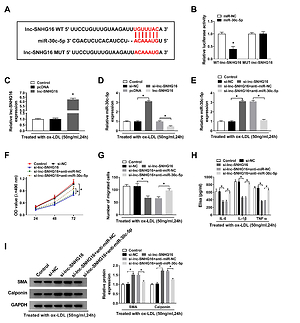Current issue
Archive
Manuscripts accepted
About the Journal
Editorial office
Editorial board
Section Editors
Abstracting and indexing
Subscription
Contact
Ethical standards and procedures
Most read articles
Instructions for authors
Article Processing Charge (APC)
Regulations of paying article processing charge (APC)
ATHEROSCLEROSIS / RESEARCH PAPER
Long non-coding RNA SNHG16 contributes to progression of carotid atherosclerosis by regulating miR-30c-5p/ADAM10 axis
1
The Third People's Hospital of Heze, China
2
Zaozhuang Hospital of T.C.M, China
3
Zaozhuang Municipal Hospital, China
Submission date: 2020-02-29
Final revision date: 2020-09-16
Acceptance date: 2020-10-01
Online publication date: 2021-05-09
KEYWORDS
TOPICS
ABSTRACT
Introduction:
Carotid atherosclerosis (CAS) is one of the main causes of cerebral infarction in the ageing population. Long non-coding RNA small nucleolar RNA host gene 16 (lnc-SNHG16) could promote the development of atherosclerosis. However, the mechanism of lnc-SNHG16 in CAS remains vague.
Material and methods:
The expression levels of lnc-SNHG16, microRNA-30c-5p (miR-30c-5p) and disintegrin and metalloproteinase 10 (ADAM10) were detected by real-time quantitative polymerase chain reaction (RT-qPCR). Cell viability and migration were detected by 3-(4, 5-dimethyl-2-thiazolyl)-2, 5-diphenyl-2-H-tetrazolium bromide (MTT) and transwell assays, severally. The levels of interleukin-6 (IL-6), IL-β and tumor necrosis factor-α (TNF-α) were assessed by enzyme-linked immunosorbent assay (ELISA). Protein levels of spinal muscular atrophy (SMA), calponin and ADAM10 were examined by western blot assay. The binding relationship between miR-30c-5p and lnc-SNHG16 or ADAM10 was predicted by Starbase, then verified by the dual-luciferase reporter assay.
Results:
Lnc-SNHG16 and ADAM10 were increased, and miR-30c-5p was decreased in CAS patient and oxidized low-density lipoprotein (ox-LDL)-treated human aortic smooth muscle cells (hASMCs). Lnc-SNHG16 silencing repressed cell viability, migration, inflammation, facilitated differentiation in ox-LDL-treated hASMCs. Moreover, mechanical analysis proved that lnc-SNHG16 improved ADAM10 expression by sponging miR-30c-5p.
Conclusions:
Our data indicated that lnc-SNHG16 could regulate the progression of ox-LDL induced CAS model by the miR-30c-5p/ADAM10 axis, implying a potential therapeutic strategy for CAS
Carotid atherosclerosis (CAS) is one of the main causes of cerebral infarction in the ageing population. Long non-coding RNA small nucleolar RNA host gene 16 (lnc-SNHG16) could promote the development of atherosclerosis. However, the mechanism of lnc-SNHG16 in CAS remains vague.
Material and methods:
The expression levels of lnc-SNHG16, microRNA-30c-5p (miR-30c-5p) and disintegrin and metalloproteinase 10 (ADAM10) were detected by real-time quantitative polymerase chain reaction (RT-qPCR). Cell viability and migration were detected by 3-(4, 5-dimethyl-2-thiazolyl)-2, 5-diphenyl-2-H-tetrazolium bromide (MTT) and transwell assays, severally. The levels of interleukin-6 (IL-6), IL-β and tumor necrosis factor-α (TNF-α) were assessed by enzyme-linked immunosorbent assay (ELISA). Protein levels of spinal muscular atrophy (SMA), calponin and ADAM10 were examined by western blot assay. The binding relationship between miR-30c-5p and lnc-SNHG16 or ADAM10 was predicted by Starbase, then verified by the dual-luciferase reporter assay.
Results:
Lnc-SNHG16 and ADAM10 were increased, and miR-30c-5p was decreased in CAS patient and oxidized low-density lipoprotein (ox-LDL)-treated human aortic smooth muscle cells (hASMCs). Lnc-SNHG16 silencing repressed cell viability, migration, inflammation, facilitated differentiation in ox-LDL-treated hASMCs. Moreover, mechanical analysis proved that lnc-SNHG16 improved ADAM10 expression by sponging miR-30c-5p.
Conclusions:
Our data indicated that lnc-SNHG16 could regulate the progression of ox-LDL induced CAS model by the miR-30c-5p/ADAM10 axis, implying a potential therapeutic strategy for CAS
We process personal data collected when visiting the website. The function of obtaining information about users and their behavior is carried out by voluntarily entered information in forms and saving cookies in end devices. Data, including cookies, are used to provide services, improve the user experience and to analyze the traffic in accordance with the Privacy policy. Data are also collected and processed by Google Analytics tool (more).
You can change cookies settings in your browser. Restricted use of cookies in the browser configuration may affect some functionalities of the website.
You can change cookies settings in your browser. Restricted use of cookies in the browser configuration may affect some functionalities of the website.



